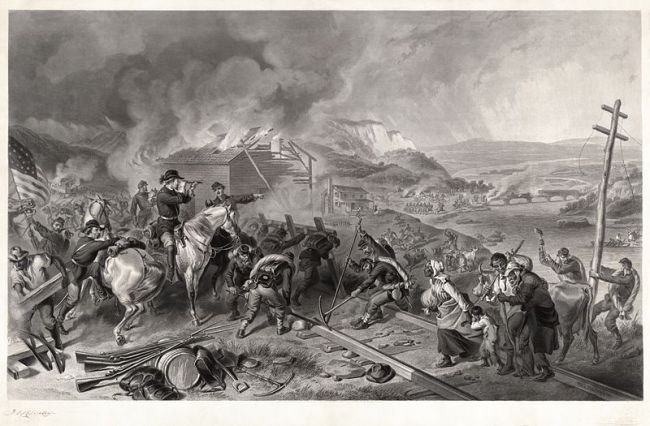The Battle of Gettysburg is considered a turning point in the Civil War because it was a defining victory for the Union army that decimated the Confederacy’s morale and ability to invade and attack the North. As the Civil War waged on, the South had begun to invade the North in the hope of lowering Union morale and gaining more ground in Northern territories. Confederate General Robert E. Lee hoped to deal a fatal blow to the Union by beginning a full-scale invasion of the North. Near the town of Gettysburg, Pennsylvania, Lee’s army clashed with the Union army led by Major General George Meade. After three days of fighting and bloodshed, Gettysburg went down in history with the largest number of casualties in the entire Civil War. The picture above, The Battle of Gettysburgby artist Thure de Thulstrup, displays the violence of The Battle of Gettysburg. For the Union, 3,155 men were killed, 14,350 wounded, and 5,365 missing, given a total of 23,040 casualties. This represented 27% out of the 918,000 men in the original Union army on December 1863. For the Confederacy, somewhere from 2,600-4,500 men were killed, 12,800 wounded, and 5,250 missing, given a total of somewhere from 20,650-25,000 casualties. This represented 30-34% out of the 278,000 men in the original Confederate army on December 1863. (DBQ Document B) In conclusion, the great percentage of casualties caused by the Battle of Gettysburg decimated the Confederacy’s morale and with Lee’s eventual resignation, the Confederacy invasion of the North came to a crashing end.
Although the Union victory at Gettysburg had greatly decimated the Confederacy’s morale, no other Union attack (or rather series of attacks) impacted the Confederacy more than the total war campaigns of the Union generals Grant, Sheridan, and Sherman. By definition total war is “a war that is unrestricted in terms of the weapons used, the territory or combatants involved, or the objectives pursued, especially one in which the laws of war are disregarded”. (Oxford Dictionary) Total war tactician Ulysses S. Grant was a Union general who won major battles of the Civil War including wins at Shiloh and Chattanooga, and for such was highly revered for his battle tactics. However, some of his tactics included the relentless bombardment of ammunition against enemy and civilian trenches, especially during the Battle of Vicksburg. In 1864, Sherman destroyed Confederate barns, railroads, and supply storages to destroy the Confederacy’s ability to wage war by ensuring that supplies would not be provided for Confederate armies. Another closely associated total war tactician was General Philip Sheridan, who was good friends with Grant. Sheridan targeted Confederate-controlled Shenandoah Valley, which was a vital supply resource and transport hub for the Confederacy. Sheridan destroyed the barns, mills, railroads, and factories to prevent the further supply of resources to Confederate troops. Sheridan proceeded to burn hundreds of miles of the Shenandoah Valley, but such was only a precursor of total war before the infamous Sherman’s March to the Sea. The picture above, Sherman’s March by Alexander Hay Ritchie, displays the destruction caused by Sherman’s March as General Sherman is portrayed ordering his men to tear up and destroy a line of Confederate rail. After Sherman had conquered the city of Atlanta by evacuating its citizens then promptly burning the city to the ground, Sherman marched hundreds of miles to the city of Savannah near the Atlantic coast. During his March to the Sea, Sherman destroyed bridges, factories, farms, fields, and especially railroads, similar to Grant and Sheridan before him. As Sherman himself quoted, “War is cruelty… the crueler it is, the sooner it will be over” (Sherman’s Letter to the Mayor of Atlanta). In conclusion, despite the successes of Grant, Sheridan, and Sherman’s tactics to destroy the Confederacy’s ability to wage war, the tactics of total war are simply unacceptable in the irreversible destruction of property, both Confederate and civilian.

After the Confederacy had lost their ability to wage war, they surrendered and the Union celebrated. The majority of the Union felt surprise and relief that the war had ended. When the news of the Confederate surrender reached Washington D.C., fireworks were lit and a crowd congregated outside of the White House and demanded Lincoln to make a speech on the Union victory. Meanwhile, Northern soldiers were paraded around for their valiant efforts, while Southern soldiers hung their heads with sadness. However, these same men were able to return into the Union not as soldiers, but as citizens of the United States. But not all Southerners returned to the Union, some, like John Wilkes Booth, drank alcohol to forget the misery of the Confederate defeat. Others, along with Booth, plotted to kill all of their new Union leaders in attempt to restart the Confederacy. All the assassins failed to kill their respective targets except for Booth. As displayed in the picture above, The Assassination of President Lincoln by printmaking firm Currier and Ives, Booth managed to slip past all guards and succeeded in assassinating the president of the United States. Although the Confederacy had failed, they only had managed to prevent Lincoln from witnessing their demise. But as Lincoln quoted, “We are not enemies, but friends. We must not be enemies. Though passion may have strained it must not break our bonds of affection” (Lincoln’s First Inaugural Address). The Union had lost its president, but after the Civil War, a truly united, United States of America had emerged.

